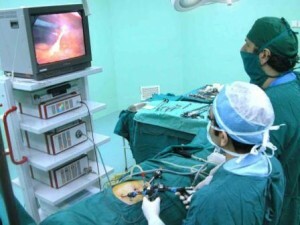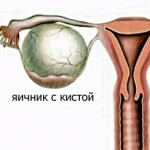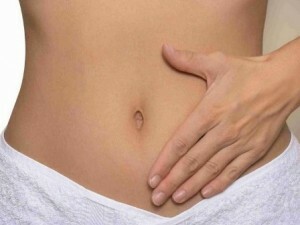Modern medical technology, if necessary, surgery to get rid of ovarian cysts allow for minimally invasive interventions. They are less costly for the patient, they make it possible to avoid long and difficult rehabilitation.
Still, those who need laparoscopy ovarian cysts, I would like to present the postoperative period in detail. Knowledge will help to avoid unnecessary fears, because the right attitude is important for successful treatment.
Features and duration of operation
 This type of intervention is performed through abdominal punctures andnot an incision, as in a normal operation. This will significantly shorten the recovery period, the soreness inherent in the rehabilitation time, will speed up healing. Nevertheless, the patient will have to endure some unpleasant sensations, follow the recommendations of the doctors for a full recovery.
This type of intervention is performed through abdominal punctures andnot an incision, as in a normal operation. This will significantly shorten the recovery period, the soreness inherent in the rehabilitation time, will speed up healing. Nevertheless, the patient will have to endure some unpleasant sensations, follow the recommendations of the doctors for a full recovery.
All manipulations occur under general anesthesia, so a woman is not able to control what is happening to her. Hence the interest in how long the laparoscopy operation of the ovarian cyst takes. The average term is 40-90 minutes. Given the possible complexity, the experience of the surgeon, the size of the lesion, the general condition of the patient, he can be more.
Immediately after
intervention Postoperative period is counted from the time of completion of the intervention to discharge from the hospital. After stopping the anesthesia, the patient feels uncomfortable, painful in the area of manipulation. This is normal, given the inevitable damage to the tissues.
If the pain is noticeable, depending on the characteristics of the body, analgesics are prescribed for its removal. There are other mandatory features of early recovery time:
- Postoperative period after laparoscopy requires the intake of antibiotics. They are needed to avoid infection, the probability of which exists, despite the minimal damage to tissues;
- Minimally invasive intervention allows you to maintain sufficient activity in the first day. After 8-10 hours a woman will be able to enter the toilet herself. From anesthesia, there is often dizziness and nausea, so it's best that they help her in this;
- Allowed in the first 5 hours to drink water without gas, if there is an appetite, you can use broth;
- Laparoscopy of the ovarian cyst is done with the use of gas, therefore the postoperative period, especially in lean women, can be accompanied by an ache in the shoulders, neck, abdomen, legs. To remove the remains of matter from the abdominal cavity, the nurse will show special exercises that make lying in bed;
- Some may be prescribed anticoagulants. From the forced lying position, which requires laparoscopy of the ovarian cyst, the postoperative time interval is capable of provoking thrombosis. In addition to medicines, special stockings that are worn before manipulation and worn after will help to avoid it.
How long does the treatment last?
The stay in the hospital lasts 7-10 days. This is necessary to control the healing of tiny seams, the general well-being of the patient, although women are able to serve themselves, move around, bathe in the shower.
The first 3-4 days can feel aching pain in puncture sites and in the abdomen. This is the result of tissue trauma. Another unpleasant feeling is weakness. It, like the pain, passes pretty quickly. Assume and raising the temperature just above 37, this is also a normal reaction to the operation. But the physician should know all the sensations in order to correctly assess their nature and possible danger.

But the completion of this period does not mean that the body is already ready to receive the habitual load of a healthy person. Have to beware:
- At least a month from sexual relations, visiting the sauna, sauna. You can wash yourself in the shower;
- Decade from lifting weights over 3 kg.
2-3 weeks it is also worth wearing pulling stockings.
But even with such low-traumatic intervention as laparoscopy of the ovarian cyst, how long the hospital last depends on so many factors:
- The size of the remote cyst;
- Presence of complications;
- General health of the patient.
If there are problems with recovery, the list of incapacity for work can be extended, in parallel appointing additional treatment, physiotherapy.
Nutrition after intervention on the ovary
 A short time after laparoscopy can pierce the discomfort in the intestines due to the action of gas, lack of mobility. In this period, there is rarely a good appetite, there may be constipation, which is struggled with the enema. Therefore, nutrition is one of the most important moments in recovery. It should support the forces, restore the digestive system, relieve of unacceptable strong attempts at defecation.
A short time after laparoscopy can pierce the discomfort in the intestines due to the action of gas, lack of mobility. In this period, there is rarely a good appetite, there may be constipation, which is struggled with the enema. Therefore, nutrition is one of the most important moments in recovery. It should support the forces, restore the digestive system, relieve of unacceptable strong attempts at defecation.
What you can eat after laparoscopy ovarian cysts:
- Weak broth in the first day. It will support, but will not overload the body;
- Kissel or jelly on the second day, you can steamed pieces of stale white bread;
- Boiled porridge, mashed soups, steamed chicken, rabbit, beef cutlets in the first week after the intervention;
- Stewed, baked vegetables, lean meat, fish in the first month.
If you eat the right foods in the optimal portions 4-6 times a day, you can avoid discomfort in the stomach, painful bloating, strong attempts at defecation.
To forget for 2-3 months is about alcohol, chocolate, sweets, coffee, strong tea, fried and fatty foods.
Maternity after removal of the cyst
But you need to take into account the nervous stress experienced through the intervention. Therefore, menstruation can begin early or be late for a couple of months. The nature of the secretions is permissible, which differs from the usual one for 1-2 cycles.
But even if the critical days have come, as by the hour, there are no changes in their course, pregnancy 3-4 menstrual periods after the operation, the sexual life - a month should be avoided.
Removal of ovarian cyst, laparoscopy, postoperative period require time for complete recovery. Some after the operation appoint a hormone intake to exclude the possibility of recurrence of cyst formation.
Naturally, all the time their use of pregnancy should be avoided. Seeking conception should be only 3 months after the rejection of hormones, that is, after six months, counting from the time of intervention.
 We recommend that you read an article on monthly ovarian cysts. You will learn about the nature of education, its impact on menstruation, the need for an operation.
We recommend that you read an article on monthly ovarian cysts. You will learn about the nature of education, its impact on menstruation, the need for an operation.
Possible Post-Operative Problems
 If the operation is performed in a good clinic by a qualified surgeon, complications after laparoscopy ovarian cysts are unlikely. But it is impossible to exclude them 100%.
If the operation is performed in a good clinic by a qualified surgeon, complications after laparoscopy ovarian cysts are unlikely. But it is impossible to exclude them 100%.
Among probable problems:
- Bleeding after intervention;
- Trauma of nearby organs;
- Vascular lesions;
- Accession of infection in the abdominal cavity;
- Suppuration of stitches;
- Thrombophlebitis;
- Pneumonia.
Fear, the probability of problems should not stop a woman from surgery. Laparoscopy of the ovarian cyst, for which the postoperative period is minimal and tolerated fairly easily, eliminates the possibility of more severe consequences: rupture of the capsule, torsion, degeneration into cancer and infertility.
